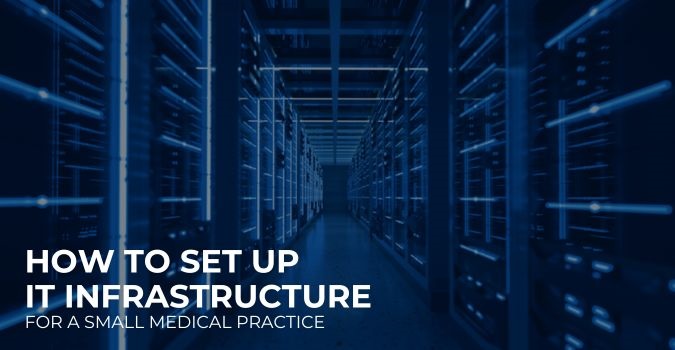In today’s fast-paced digital world, artificial intelligence (AI) is transforming industries globally, with healthcare leading…

How To Setup IT Infrastructure for A Small Medical Practice
A well-functioning IT infrastructure is the backbone of any successful medical practice. It ensures smooth operations, secure patient data storage, and efficient communication – all crucial for delivering exceptional patient care. However, setting up IT infrastructure for a small practice can seem daunting. In this blog, we will explore the key elements and provide helpful tips for setup IT Infrastructure for a Small Medical Practice.
Things To Consider for Setup IT Infrastructure
Setup IT infrastructure involves several essential components that work together to ensure the efficient and secure operation of an organisation’s technology ecosystem. Here are the key elements that need to consider:
Selection of the Right Hardware and Software
Once you’ve assessed your needs, it’s time to choose the right hardware and software. Some common components of a small healthcare practice IT infrastructure include:
- Servers: These will store your Electronic Health Records (EHR) and other critical data. For small clinics, cloud-based servers may be a more cost-effective and scalable option.
- Workstations: Computers for doctors, nurses, and administrative staff are essential for accessing patient records, scheduling appointments, and managing workflows.
- Networking Equipment: Routers, switches, and Wi-Fi access points ensure seamless connectivity across your practice.
- Healthcare Software: Tools like practice management software, billing systems, and EHR solutions are fundamental in modern healthcare IT infrastructure. Ensure the software integrates seamlessly with your clinic’s workflow.
Ensure Data Security and HIPAA Compliance
Securing patient data is critical for any medical practice IT infrastructure. Your clinic must comply with regulations like HIPAA regulations, depending on your location.
- Data Encryption: Protect sensitive data both in transit and at rest using strong encryption protocols.
- Access Control: Implement role-based access to ensure only authorised personnel can access patient data.
- Regular Data Backups: Automate regular backups to protect against data loss due to hardware failure or cyber-attacks.
- Firewalls and Antivirus: Install network firewalls and antivirus software to protect against external threats.
Implement Backup and Disaster Recovery Solutions
Data loss can be devastating for any medical practice, especially one that deals with sensitive patient information. A strong disaster recovery plan ensures your clinic can quickly recover from unexpected disruptions, such as natural disasters, cyberattacks, or hardware failure.
- Cloud Backup Solutions: Automatically store copies of important files and EHR in the cloud for easy access and recovery.
- On-Site Backups: Use local storage devices for daily backups as a secondary option.
- Disaster Recovery Plans: Ensure your IT infrastructure has protocols in place to minimise downtime in case of an emergency.
Opt for Scalable IT Solutions
As your small clinic grows, so will your IT infrastructure needs. It’s essential to choose scalable solutions that can expand with your practice. Cloud-based servers, virtual desktops, and modular software systems make it easy to add new users, equipment, and services as your clinic expands.
For expert guidance on scalable healthcare IT solutions, MedicalIT.Services offer tailored IT support services for clinics of all sizes, ensuring that your practice stays up-to-date with technology and remains secure as you grow.
Consider Managed IT Services
For small medical practices, managing IT infrastructure internally can be both time-consuming and costly. Outsourcing IT setup and maintenance to a healthcare IT solutions provider can save you time, reduce operational costs, and improve efficiency.
Providers like MedicalIT.Services specialise in medical practice IT infrastructure. They can offer round-the-clock support, monitor your systems for potential issues, and ensure compliance with the latest healthcare regulations.
Conclusion
Setting up IT infrastructure for a small medical practice may seem daunting, but by following these steps, you can ensure that your clinic operates smoothly, securely, and in compliance with regulations. From selecting the right hardware and software to ensuring data security and scalability, a well-planned IT setup is essential for any modern healthcare practice.
For expert assistance with your clinic’s IT infrastructure, consider partnering with MedicalIT.Services, which offers specialised IT support services designed to meet the unique needs of healthcare practices. Let them take care of your IT setup so you can focus on providing excellent care to your patients.
Also Read:



